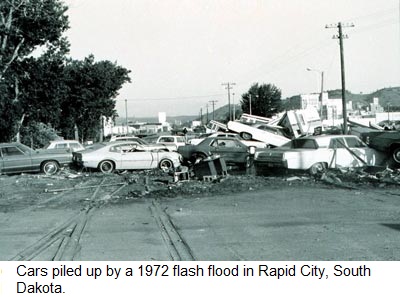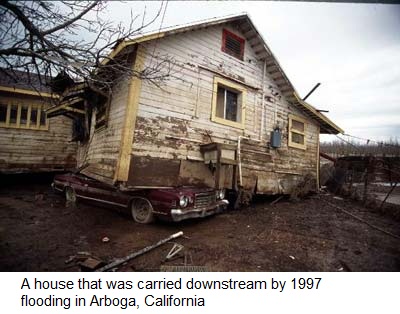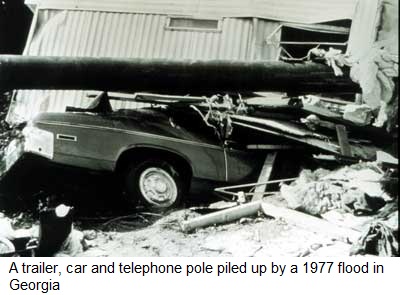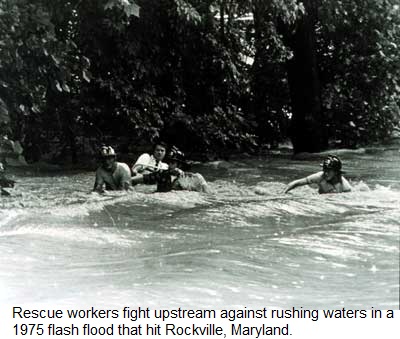|
|
|
|
 The
worst damage from floods, the loss of life and homes, is caused
primarily by the sheer force of flowing water. In a flood, two feet (61
cm) of water can move with enough force to wash a car away, and 6 inches
(15 cm) of water can knock you off your feet. It may seem surprising
that water, even a lot of water, can pack such a wallop. After all, you
can peacefully swim in the ocean without being knocked around, and
that's a massive amount of moving water. And in most cases, a flowing
river isn't strong enough to knock you over. So why do flood waters
behave differently? The
worst damage from floods, the loss of life and homes, is caused
primarily by the sheer force of flowing water. In a flood, two feet (61
cm) of water can move with enough force to wash a car away, and 6 inches
(15 cm) of water can knock you off your feet. It may seem surprising
that water, even a lot of water, can pack such a wallop. After all, you
can peacefully swim in the ocean without being knocked around, and
that's a massive amount of moving water. And in most cases, a flowing
river isn't strong enough to knock you over. So why do flood waters
behave differently?
 Flood
waters are more dangerous because they can apply much more pressure than
an ordinary river or a calm sea. This is due to the massive differences
in water volume that exist during many floods. In a flood, a lot of
water may collect in an area while there is hardly any water in another
area. Water is fairly heavy, so it moves very quickly to "find its own
level." The bigger the difference between water volumes across an area,
the greater the force of movement. But at a particular point, the water
doesn't look so deep, and so doesn't seem particularly dangerous --
until it's too late. Nearly half of all flood deaths result from people
attempting to drive their cars through rushing water. There is much more
water in the ocean than in a flood, but it doesn't knock us over because
it is fairly evenly distributed -- water in a calm sea isn't rushing to
find its own level. Flood
waters are more dangerous because they can apply much more pressure than
an ordinary river or a calm sea. This is due to the massive differences
in water volume that exist during many floods. In a flood, a lot of
water may collect in an area while there is hardly any water in another
area. Water is fairly heavy, so it moves very quickly to "find its own
level." The bigger the difference between water volumes across an area,
the greater the force of movement. But at a particular point, the water
doesn't look so deep, and so doesn't seem particularly dangerous --
until it's too late. Nearly half of all flood deaths result from people
attempting to drive their cars through rushing water. There is much more
water in the ocean than in a flood, but it doesn't knock us over because
it is fairly evenly distributed -- water in a calm sea isn't rushing to
find its own level.
The most dangerous floods are flash floods, which are caused by a
sudden, intense accumulation of water. Flash floods hit an area soon
after water begins to accumulate (whether from excessive rain or another
cause), so a lot of the time, people don't see them coming. Since there
is a great deal of water collected in one area, flash-flood waters tend
to move with a great deal of force, knocking people, cars and even
houses out of the way. Flash floods can be particularly devastating when
a heavy thunderstorm dumps a high volume of rain on a mountain. The
water moves down the mountain at tremendous speed, plowing through
anything in the valleys below.
 One
of the worst flash floods in U.S. history occurred in 1976, in Big
Thompson Canyon, Colorado. In less than five hours, thunderstorms in
nearby areas dumped more rain than the region ordinarily experiences in
a year. The Big Thompson River, normally a shallow, slow-moving
waterway, abruptly transformed into an unstoppable torrent, dumping
233,000 gallons (882,000 L) of water into the canyon every second.
Thousands of campers had gathered in the canyon to celebrate the
centennial of the state of Colorado. The flood happened so quickly that
there was no time to issue a warning. When it hit, hundreds of people
were injured, and 139 were killed. One
of the worst flash floods in U.S. history occurred in 1976, in Big
Thompson Canyon, Colorado. In less than five hours, thunderstorms in
nearby areas dumped more rain than the region ordinarily experiences in
a year. The Big Thompson River, normally a shallow, slow-moving
waterway, abruptly transformed into an unstoppable torrent, dumping
233,000 gallons (882,000 L) of water into the canyon every second.
Thousands of campers had gathered in the canyon to celebrate the
centennial of the state of Colorado. The flood happened so quickly that
there was no time to issue a warning. When it hit, hundreds of people
were injured, and 139 were killed.
A less catastrophic sort of damage is simple dampness. Most buildings
can keep out the rain, but they aren't built to be water-tight. If the
water level is high enough, loads of water seeps into houses, soaking
everything. But in most cases, the major damaging element is not the
water itself, but the mud it brings with it. As water flows over the
landscape, it picks up a lot of junk. When the flood is over, the water
level drops and everything eventually dries out, but the mud and debris
stick around.
 In
1966, a major storm flooded the Arno, an Italian river that runs through
the city of Florence. The small city, one of the art capitals of the
world, was overrun with water, mud and general slime. In addition to the
loss of life and the damage to buildings, there was a great deal of
damage to the city's art collection. Mud and slime covered almost
everything stored in the city's basements and ground-level rooms.
Through many years of work, scientists and art historians have been able
to restore most of the damaged artifacts to good condition. In
1966, a major storm flooded the Arno, an Italian river that runs through
the city of Florence. The small city, one of the art capitals of the
world, was overrun with water, mud and general slime. In addition to the
loss of life and the damage to buildings, there was a great deal of
damage to the city's art collection. Mud and slime covered almost
everything stored in the city's basements and ground-level rooms.
Through many years of work, scientists and art historians have been able
to restore most of the damaged artifacts to good condition.
Another sort of flood damage is the spread of disease. As water flows
over an area, it can pick up all sorts of chemicals and waste products,
leading to extremely unsanitary conditions. Essentially, everything and
everyone in a flood is floating along in one big soup. While diseases
usually aren't created by these conditions, they are more easily
transferred (most diseases spread through water more readily than they
move through the air). If you are in a flooded area, it is very
important that you drink only bottled or boiled water and observe other
sanitation guidelines. To learn more about what to do in flooded
conditions, check out this guide put out by the Center for Disease
Control.
We'll never be able to stop flooding. It is an unavoidable element in
the complex weather system of our atmosphere. We can, however, work to
minimize the damage inflicted by flooding, by building sophisticated
dams, levees and canal systems. But the best way to avoid flood damage
may be to back out of flood-prone areas altogether. As with many natural
phenomena, the most sensible reaction to flooding may be to get out of
the way.

Source: http://science.howstuffworks.com |
|


 The
worst damage from floods, the loss of life and homes, is caused
primarily by the sheer force of flowing water. In a flood, two feet (61
cm) of water can move with enough force to wash a car away, and 6 inches
(15 cm) of water can knock you off your feet. It may seem surprising
that water, even a lot of water, can pack such a wallop. After all, you
can peacefully swim in the ocean without being knocked around, and
that's a massive amount of moving water. And in most cases, a flowing
river isn't strong enough to knock you over. So why do flood waters
behave differently?
The
worst damage from floods, the loss of life and homes, is caused
primarily by the sheer force of flowing water. In a flood, two feet (61
cm) of water can move with enough force to wash a car away, and 6 inches
(15 cm) of water can knock you off your feet. It may seem surprising
that water, even a lot of water, can pack such a wallop. After all, you
can peacefully swim in the ocean without being knocked around, and
that's a massive amount of moving water. And in most cases, a flowing
river isn't strong enough to knock you over. So why do flood waters
behave differently? Flood
waters are more dangerous because they can apply much more pressure than
an ordinary river or a calm sea. This is due to the massive differences
in water volume that exist during many floods. In a flood, a lot of
water may collect in an area while there is hardly any water in another
area. Water is fairly heavy, so it moves very quickly to "find its own
level." The bigger the difference between water volumes across an area,
the greater the force of movement. But at a particular point, the water
doesn't look so deep, and so doesn't seem particularly dangerous --
until it's too late. Nearly half of all flood deaths result from people
attempting to drive their cars through rushing water. There is much more
water in the ocean than in a flood, but it doesn't knock us over because
it is fairly evenly distributed -- water in a calm sea isn't rushing to
find its own level.
Flood
waters are more dangerous because they can apply much more pressure than
an ordinary river or a calm sea. This is due to the massive differences
in water volume that exist during many floods. In a flood, a lot of
water may collect in an area while there is hardly any water in another
area. Water is fairly heavy, so it moves very quickly to "find its own
level." The bigger the difference between water volumes across an area,
the greater the force of movement. But at a particular point, the water
doesn't look so deep, and so doesn't seem particularly dangerous --
until it's too late. Nearly half of all flood deaths result from people
attempting to drive their cars through rushing water. There is much more
water in the ocean than in a flood, but it doesn't knock us over because
it is fairly evenly distributed -- water in a calm sea isn't rushing to
find its own level. One
of the worst flash floods in U.S. history occurred in 1976, in Big
Thompson Canyon, Colorado. In less than five hours, thunderstorms in
nearby areas dumped more rain than the region ordinarily experiences in
a year. The Big Thompson River, normally a shallow, slow-moving
waterway, abruptly transformed into an unstoppable torrent, dumping
233,000 gallons (882,000 L) of water into the canyon every second.
Thousands of campers had gathered in the canyon to celebrate the
centennial of the state of Colorado. The flood happened so quickly that
there was no time to issue a warning. When it hit, hundreds of people
were injured, and 139 were killed.
One
of the worst flash floods in U.S. history occurred in 1976, in Big
Thompson Canyon, Colorado. In less than five hours, thunderstorms in
nearby areas dumped more rain than the region ordinarily experiences in
a year. The Big Thompson River, normally a shallow, slow-moving
waterway, abruptly transformed into an unstoppable torrent, dumping
233,000 gallons (882,000 L) of water into the canyon every second.
Thousands of campers had gathered in the canyon to celebrate the
centennial of the state of Colorado. The flood happened so quickly that
there was no time to issue a warning. When it hit, hundreds of people
were injured, and 139 were killed. In
1966, a major storm flooded the Arno, an Italian river that runs through
the city of Florence. The small city, one of the art capitals of the
world, was overrun with water, mud and general slime. In addition to the
loss of life and the damage to buildings, there was a great deal of
damage to the city's art collection. Mud and slime covered almost
everything stored in the city's basements and ground-level rooms.
Through many years of work, scientists and art historians have been able
to restore most of the damaged artifacts to good condition.
In
1966, a major storm flooded the Arno, an Italian river that runs through
the city of Florence. The small city, one of the art capitals of the
world, was overrun with water, mud and general slime. In addition to the
loss of life and the damage to buildings, there was a great deal of
damage to the city's art collection. Mud and slime covered almost
everything stored in the city's basements and ground-level rooms.
Through many years of work, scientists and art historians have been able
to restore most of the damaged artifacts to good condition.